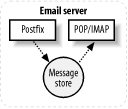POP and IMAP
After Postfix has delivered a message, users need a way to read it. Many sites provide a POP/IMAP server for users to retrieve their email messages over the network. In most cases Postfix works seamlessly with POP/IMAP servers, so that no special configuration is required on either side.
7.4.1 POP Versus IMAP
The POP protocol works best when you have limited, or less than full-time, network access because it allows you to connect to your mail server, fetch all of your messages, and disconnect from the network. You now have local copies that you can read offline. Most POP clients have a configuration option to delete your messages from the server when you retrieve them, since you then have the local copies. If you don't delete them at some time, the messages accumulate, taking up more and more space on your mail server. POP was designed to be easy to implement, but the major problem with the POP protocol is that if you ever work from more than one computer, your messages may not be where you need them. It also does not handle multiple mailboxes very well, and it forces you to download complete messages. There is no option to retrieve just the subject, for example, to decide if you want the complete message.
The IMAP protocol was designed to overcome some of POP's shortcomings. It keeps all messages on the server. You have to be connected while working with your email messages, but you can manage them as if they were local. Since everything happens on the server, it doesn't matter if you work from your desktop computer at home, another machine at work, and even on a laptop while traveling. IMAP still allows for saving messages locally, if necessary, and it also provides much more flexibility than POP. You can download just the headers from your messages and then decide to retrieve the rest of a message if you want to read it. You don't have to be stuck downloading a huge message or attachment that you might not be interested in. You can maintain multiple mailboxes and folders on the IMAP server.
7.4.2 Postfix and POP/IMAP Servers
The cooperation between Postfix and POP/IMAP servers is simple. When Postfix accepts delivery of an email message, it places it in the message store. The POP/IMAP server simply retrieves messages from the same store when a user requests them. Figure 7-1 shows how simple the cooperation is between Postfix and POP/IMAP servers. Postfix and the POP/IMAP server must agree on the type of mailbox format and the style of locking. Postfix should work with any standards-compliant POP/IMAP server that uses one of the traditional message stores. You may have to adjust the mail_spool_directory parameter, as described earlier in the chapter, but for most POP/IMAP servers, you can simply follow the standard installation instructions and start the server. For POP/IMAP servers that don't use a traditional message store, Postfix can still deliver messages using the Local Mail Transfer Protocol, which is discussed in the next section.
Figure 7-1. Postfix and POP/IMAP servers

Introduction
- Introduction
- Postfix Origins and Philosophy
- Email and the Internet
- The Role of Postfix
- Postfix Security
- Additional Information and How to Obtain Postfix
Prerequisites
Postfix Architecture
- Postfix Architecture
- Postfix Components
- How Messages Enter the Postfix System
- The Postfix Queue
- Mail Delivery
- Tracing a Message Through Postfix
General Configuration and Administration
- General Configuration and Administration
- Starting Postfix the First Time
- Configuration Files
- Important Configuration Considerations
- Administration
- master.cf
- Receiving Limits
- Rewriting Addresses
- chroot
- Documentation
Queue Management
Email and DNS
Local Delivery and POP/IMAP
- Local Delivery and POP/IMAP
- Postfix Delivery Transports
- Message Store Formats
- Local Delivery
- POP and IMAP
- Local Mail Transfer Protocol
Hosting Multiple Domains
- Hosting Multiple Domains
- Shared Domains with System Accounts
- Separate Domains with System Accounts
- Separate Domains with Virtual Accounts
- Separate Message Store
- Delivery to Commands
Mail Relaying
- Mail Relaying
- Backup MX
- Transport Maps
- Inbound Mail Gateway
- Outbound Mail Relay
- UUCP, Fax, and Other Deliveries
Mailing Lists
Blocking Unsolicited Bulk Email
- Blocking Unsolicited Bulk Email
- The Nature of Spam
- The Problem of Spam
- Open Relays
- Spam Detection
- Anti-Spam Actions
- Postfix Configuration
- Client-Detection Rules
- Strict Syntax Parameters
- Content-Checking
- Customized Restriction Classes
- Postfix Anti-Spam Example
SASL Authentication
- SASL Authentication
- SASL Overview
- Postfix and SASL
- Configuring Postfix for SASL
- Testing Your Authentication Configuration
- SMTP Client Authentication
Transport Layer Security
Content Filtering
External Databases
Appendix A. Configuration Parameters
Appendix B. Postfix Commands
Appendix C. Compiling and Installing Postfix
- Appendix C. Compiling and Installing Postfix
- C.1. Obtaining Postfix
- C.2. Postfix Compiling Primer
- C.3. Building Postfix
- C.4. Installation
- C.5. Compiling Add-on Packages
- C.6. Common Problems
- C.7. Wrapping Things Up
Appendix D. Frequently Asked Questions
EAN: 2147483647
Pages: 130
- ERP Systems Impact on Organizations
- Enterprise Application Integration: New Solutions for a Solved Problem or a Challenging Research Field?
- Data Mining for Business Process Reengineering
- Intrinsic and Contextual Data Quality: The Effect of Media and Personal Involvement
- Development of Interactive Web Sites to Enhance Police/Community Relations
